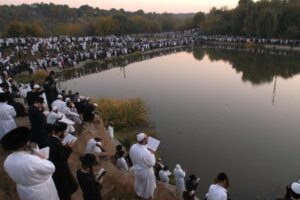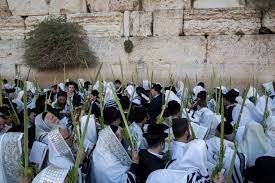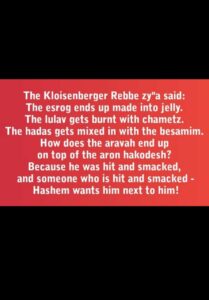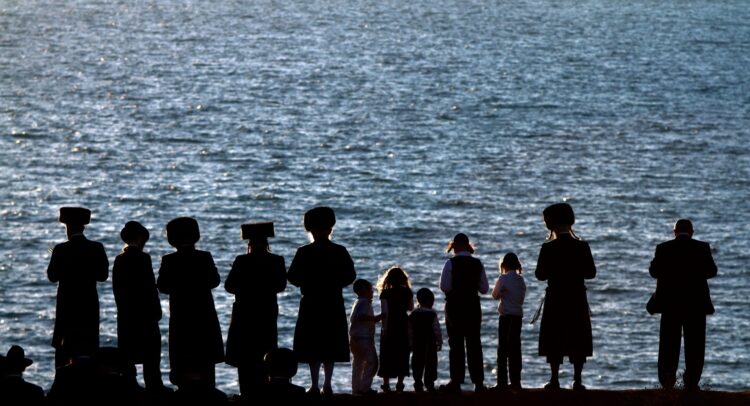Raboyseyee and Ladies:
Solving Traffic Issues & Man Made Holidays and Customs:
Long before the IRS extended the final deadline for the filing of tax returns until the 17th of October -this year and in every year when the 15th falls on the heylige Shabbis- the RBSO gave us an extension of sorts, a last-minute opportunity to ask for His forgiveness. Did He? Or was that man-made? More on that below.
We’re in the home stretch of Yomim Toivim (Holidays) and by the time we return to our regular schedules this coming Wednesday (Tuesday for those living and spending Sukkis in Israel), many of you will have, during the holy month of Tishray, which contains four Jewish holidays, consumed an overabundance of challah, cake, kugil, herring, scotch, kichel and dessert. Many of you are already wearing your fat suits, spanx and anything else in a desperate attempt to look epes a shtikel thinner than you really are. Many are making promises you have no shot of keeping about joining the gym and losing the pounds piled on eating like chazerim. Where is it written that you must eat at every kiddish?
Shoin! We’ve beaten our collective chests hundreds of times, we’ve killed tens of thousands of unsuspecting innocent chickens, we’ve pledged and even given extra charity, we’ve gone a full 25 hours and then some without eating or drinking, and we’ve prayed our hearts out; are we done yet? Are we forgiven? Are our slates clean? Is there anything left to do -be it real or symbolic? And the good news: indeed, there is! For those who haven’t yet performed the Tashlich ceremony, you have until Hoishana Rabbah – yes, this coming Sunday, to symbolically unload your sins.
What the hec is Tashlich? Where is it? How did it get its name? Does one go to Tashlich? Or, does one go elsewhere and then recite the Tashlich payer? Who invented it? When? Why? Is Tashlich a mitzvah? A Commandment? Or, but a custom? Shoin, let’s find out. Can we really throw away our sins by the recitation of a few paragraphs? Does it help if we throw in some bread? Bread crumbs? Entire slices or even loaves? Who started this practice? Why is it controversial? Is it still practiced? Shoin, I’m getting a headache.
The bottom line: kimat everyone the Ois knows in the orthodox world, make their way to Tashlich, mostly on Rosh Hashono. The Ois admits that there have been years when he did not make it to Tashlich on Yom Tov and recalls vividly one year when he parked his car near Bay Parkway in Brooklyn and made his way to the pathway along the water to recite last minute Tashlich. He was not alone. Seemingly, our rabbis extended the time allotted to recite the Tashlich, to discard our aveyris (sins), until Hoishana Rabba. And the good news? Even at that late date and hour, the Ois was not alone. There, along the water, he found many Chasidim and their families. It was an outing.

How did Tashlich come about? Who invented Tashlich and its prayers? Says Rabbi Art Scroll whose booklet the Ois was reading that day: Tashlich is observed by both Ashkenazi and Sephardic Jews. OMG! And says Rabbaynu Chaim Vital: it is a minhag among Ashkenazi Jews to go on the first day of Rosh Hashono (though the second day is ok in case of inclement weather), just after mincha but before shkia (sunset) to a big ocean, or any smaller river, or body of running water, preferably containing live fish, to recite the Tashlich prayer. And, he continues: “it is a nice custom; very nice, if one goes outside the city and stands at the edge of the water and reads the three verses found near the end of the book of Micha.” Who is Micha? Micha was one of the later Prophets who is perhaps most well-known for the last three verses he wrote which are read as the last three verses of the Haftora’s on shabbis shuva (shabbis of repentance), as well, at the haftora read at mincha on Yom Kippur. What do these verses say? “Who G-d is like You, Who pardons iniquity and overlooks transgression for the remnant of His heritage” (Micha 7:18-20). Pardons are good!
Says the Ta’ami Haminhogim, azoy: the reason we recite Tashlich near a river that has fish is this. The medrish tells us that when our zeyda Avrohom took his only and beloved son Yitzchok -while being tested by the RBSO- to the Akeydo (the binding), he needed to cross a body of water. And? Along came the Soton (Satan -bad guy that he is) intending to thwart Avrohom’s plans. Avrohom was determined and made his way into the river where soon enough its waters were at his neck. Avrohom yelled out “help me Hashem, for the waters have arrived at my neck.” Seeing Avrohom’s devotion, the RBSO saved Avrohom (who seemingly could not swim): they continued on their journey to the Akeydo. And? What have fish and a river to do with Tashlich? We’re getting to that; hold on! Says the good book: the river we say Tashlich at should have fish. Moreover, some people have the custom to throw bread into the waters. Why? Because we need to remember and recall that the Yiddin are like fish. We are? Ober, aren’t we more like behaymis (animals), if you chap, most of the year? Fish? Indeed, we are like fish who get suddenly caught in the netting which is laid out to trap them. By throwing bread to the fish, we show compassion. So too is mankind always flirting with danger (bad behavior) and in need of the RBSO’s compassion. We need to be saved -mostly from ourselves! And? By feeding the fish who are in danger, by showing them compassion, we are hopeful that the RBSO will show us compassion as well. By internalizing that the fish are in danger of suddenly being caught up in the netting, we will be spiritually moved to repentance and to get back on track with better behavior. Gishmak! Ober, says the Maharil: the custom of throwing bread into the water is a bad custom! Shoin.
There is seemingly also a custom to shake out the corners of one’s clothing while at Tashlich. Why does one shake out the corners of his clothing? Seemingly this custom allows one to shake off any klipos (lit: spiritual shells or peels) which have become attached to us during the year as a result of some form of misconduct, typically sexual, if you chap. What? Shoin, this topic is way too deep and kabalistic and not for us, or for today, ober, klipos seemingly attach to us whenever we sin -either sexually or otherwise, and especially so when the sins are of a sexual nature. Mistama you know whereof the Ois speaks. Therefore, the custom is to shake these bad boys off our bodies. How this works, ver veyst? He goes on to say that it’s specifically the custom to shake out the corners of our Tzitzis (fringes). Why? Ver veyst? Ober says the Ois: one must be careful not to shake too much, if you chap, lest one create new klipos and more of these bad boy klipis get attached. The cycle begins again. The bottom line: this shaking is seemingly performed mostly by Chasidim. Why? Ver veyst?
When was Tashlich invented? The earliest printed reference to Tashlich comes from the Maharil who mentions Tashlich without citing a source. In other words: Tashlich is a made up minhag (custom) that seemingly took off, and remained popular. Says the RambaM “minhag yisroel Toirah hu,” (a custom of the Yiddin has the status of Toirah). Ober doesn’t the heylige Toirah specifically warn us not to add or subtract any mitzvis? Indeed it does. Ober, it appears that customs may be exempt; they seemingly snuck in the back door, and Tashlich, with or without bread being cast to symbolically throw away one’s sins, remains popular. Psychologically, it makes people feel better about themselves. Good luck cleaning your slates.
Ober before we begin the last legs of this festive Yom Tov which includes Shmini Atzeres, a day when, in addition to the regular loshoin horo we speak in shul, we also discuss and argue about whether or not we are commanded -or not- to eat in the succah, and Simchas Toirah, a day when we celebrate the completing of the Toirah reading cycle, we have to get by Hoishana Rabba. What is it, how do we do it, why do we do it, and what do we do? But first….
If you thought your fate was sealed on Yom Kippur and that since you’re still alive and kicking, the RBSO must have forgiven the myriad chatoim (sins), you committed this past year, wake up, smell the coffee and welcome to Hoishana Rabba. We are taught that Hoishana Rabba is the last chance we have to somehow appease the RBSO. Though not mentioned in the heylige Toirah by name, it appears that many generations back, some rabbis decided that we needed one last day and one last opportunity to ask the RBSO for forgiveness before sentences decreed on Yom Kippur would be executed. In other words: our good rabbis got us an extension. We seemingly have one last chance to have the RBSO tear up the decree. And after klapping (beating) our chests kimat (nearly) 500 times on Yom Kippur, on this day, we get to bang one more time, if you chap. Can banging an innocent Hoishana (willow) save your life? Lommer lernin epes (learn something) about this special day we call Hoishana Rabba. On Hoishana Rabba, we are commanded to grab five tightly wound willows and perform some sadistic act, one that many of my early rebbes practiced all year with wood, sometimes their own, if you chap. On this day we pay but $5-10 dollars for this thrill. As an aside, during the year this thrill can run $150 for a 30-minute session.
First the facts:
1-Hoishana Rabbah is the seventh and last day of Sukkois. Is that emes? Not according to all, and soon, space permitting, we’ll check in on this machloikes (argument).
2- There is no mention of this day in the heylige Toirah.
3- Hoishana Rabbah is known as the day of the final sealing of judgment which began on Rosh Hashono: Hoishana Rabbah is somewhat similar to Yom Kippur.
- Hoishana Rabbah is one of the most interesting and lofty days of the year. On one hand it is a regular weekday, part of chol hamoed (intermediate days) of Sukkois. On the other hand, it’s a Holiday unto itself.
5- It has its source in the traditions of the prophets.
Where did it come from? Who invented it and decided to add it to our calendar? Says the heylige Mishnah (Sukkah 4:5): the custom, way back in the days of the Beis Hamikdash (Temple), was to circle the Mizbayach with large willow branches, one time on each day of Sukkis and seven times on the seventh day. So too we circle the Bimah reciting Hoishanis once daily during each day of Sukkis and seven Hoishanis on the seventh day. It’s mashma (therefore appears) that Hoishana Rabba is aptly named because more hoishanis (Hoshannas) are recited on this day than all the previous days of the holiday. Shoin. On this day, instead of one clumsy attempt at circling the bimah, while holding our lulavim and esrogim in one hand and juggling awkwardly the siddur in the other, we do this seven times.

The bottom line: how will Yiddin ever agree on ways to solve traffic challenges in their local neighborhoods if they cannot figure out how to properly circle the bima? Let’s get real: if we’re not capable of organized hoishanis around the bima without cars, how will we ever figure out traffic issues? Oy vey!

The highlight of the morning is the klapping (banging) of the Hoishanis, a custom that even the veyber and kinderlach (women and children) perform; seemingly a good hoishana bang is enjoyed by all, if you chap.
Exactly how this custom of Hoishana banging, of beating silly and into submission the innocent hoisanhis for which we just paid between $5 and 10, seemingly atones for our sins, ver veyst? And as one would expect to hear, there are at least four different opinions on when one should bang the hoishana; timing, as always in these matters, seems to be critical, if you chap.
Some bang immediately before the final Kaddish, some in the middle of Kaddish before Tiskabel, and some, after the end of Kaddish. This last option was the minhag of the Arizal and is quoted by the Baer Haitiv. Those who want special consideration, begin the banging the night before, if you chap. Oisvorfs klapp whenever the opportunity presents.
How much banging is in order? Nu, again this depends on who you ask but here the most popular: Some say that one is to bang two or three times, on the floor or on vessels. Not bad for $5, if you chap. Says the Arizal: we are to bang specifically on the floor five times. This signifies that we are ‘burying’ the judgment. And, says the Ben Ish Chai: the banging surface must be specifically unpaved, virgin earth. Is virgin earth better, ver veyst? Not all agree, and there appears to be some advantage to banging on vessels for they cause the leaves to fall off, which symbolizes shredding of the disastrous decrees. Say the Pri Megadim and the Mishna Berura: banging should follow the Arizal’s recommendation: one should bang to the floor and to continue banging on vessels until some of the leaves fall off. Too much banging is avada not recommended and, says the Chaya Odom: continuous banging until all the leaves fall off is childish gleeful play.
Having vented our frustrations on the poor willows and having performed what appears to be an ancient sadomasochistic act with hoishanis now behind us, we feel mamish givaldig, relieved and ready to watch football and baseball playoffs until Yom Tov begins. Hey, I’m just saying it as it is; so, shoot me! And in a last strange custom the Ois never chapped, instead of discarding the hoishanis as we do with other things we just klapped, if you chap, we throw the beaten Arovois (5 willows tied together) on top of the Oron Koidesh which houses the heylige Toira(s)? What’s pshat? Does all this make sense? Ober said the holy Kloisenberger rebbe (a revered rabbi and holocaust survivor), azoy: “the esrog end up made into jelly. The lualv gets burnt with the chomatze before Pesach. The hadasim get mixed in with the bisamim. How do the aravos end up on top of the Aron Kodesh? Because it was hit and smacked. Someone who is hit and smacked around, Hashem wants that person next to Him. Gishmak!

Chag Somayach!
The Heylige Oisvorfer Ruv
Yitz Grossman
